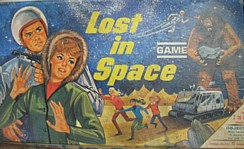A Look at Vintage Sci-Fi and Horror Board Games of the 30's to the 70's
James Burrell

King Kong Game, Ideal Toy Corp., 1976.

Game board for Creature From the Black Lagoon Mystery Game, Hasbro, 1963.

The Munsters Card Game, Milton Bradley, 1964.

Lost in Space Game, Milton Bradley, 1965.

Star Trek Game, Ideal Toy Corp., 1967.

Barnabus Collins Dark Shadows Game, Milton Bradley, 1969.
One of cinema’s greatest sci-fi film series Planet of the Apes spawned an interesting board game in 1974. Released by Milton Bradley, the game featured a cage in the center of the board in which players were to try and trap their opponents within. By rolling two dice, a player would move him/herself with one dice, and an opponent with the other.

The Game of Jaws, Ideal Toy Corp., 1975.
The following year saw a remake of one of the most revered film classics of all time: King Kong. Helmed by producer Dino De Laurentiis and starring Jeff Bridges and Jessica Lange, this 1976 redux was an entertaining, grandiose (if at times, slightly campy) piece of filmmaking and Ideal’s game tried to replicate the spectacle of the film by featuring by having players trying to stop Kong before he reaches the top of the World Trade Center. Featuring a double-sized board designed to look like the Center - along with Kong and miniature Special Attack Team game pieces, the game’s box featured the film’s original and striking movie poster artwork of Kong straddling the Center’s twin towers. In the immediate aftermath of the tragic 9/11 events, the game was temporarily commanding high prices on eBay until site officials decided to shut down the auctions (and others where WTC memorabilia was being sold at exorbitant amounts) – deeming them in bad taste and exploitative of the emotional state of many people.

Star Wars Escape From Death Star Game, Kenner, 1977
Fondly remembered and treasured by fans - both young and the young-at-heart, these classic games are the epitome of a bygone era: a simpler, more relaxed time when we could always take some time out for a game (of the non-pixilated type), have some fun and share a laugh or two with friends and family.
James Burrell is a Toronto-based writer whose work has appeared in numerous Canadian newspapers and magazines including the award-winning Rue Morgue. He is also an avid collector who has been acquiring vintage monster, science-fiction and superhero toys and movie collectibles for twenty-five years.